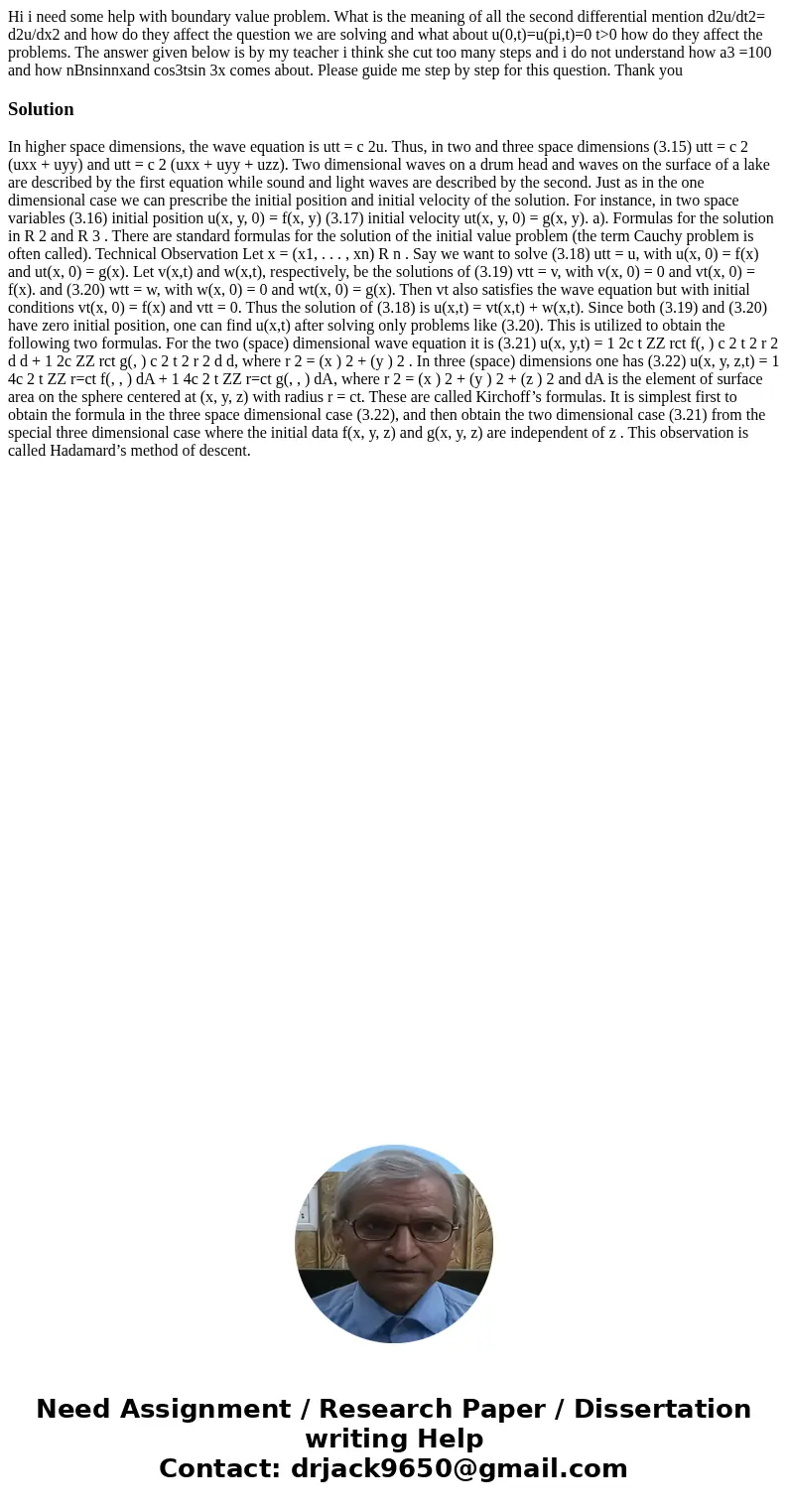Hi i need some help with boundary value problem What is the
Hi i need some help with boundary value problem. What is the meaning of all the second differential mention d2u/dt2= d2u/dx2 and how do they affect the question we are solving and what about u(0,t)=u(pi,t)=0 t>0 how do they affect the problems. The answer given below is by my teacher i think she cut too many steps and i do not understand how a3 =100 and how nBnsinnxand cos3tsin 3x comes about. Please guide me step by step for this question. Thank you
Solution
In higher space dimensions, the wave equation is utt = c 2u. Thus, in two and three space dimensions (3.15) utt = c 2 (uxx + uyy) and utt = c 2 (uxx + uyy + uzz). Two dimensional waves on a drum head and waves on the surface of a lake are described by the first equation while sound and light waves are described by the second. Just as in the one dimensional case we can prescribe the initial position and initial velocity of the solution. For instance, in two space variables (3.16) initial position u(x, y, 0) = f(x, y) (3.17) initial velocity ut(x, y, 0) = g(x, y). a). Formulas for the solution in R 2 and R 3 . There are standard formulas for the solution of the initial value problem (the term Cauchy problem is often called). Technical Observation Let x = (x1, . . . , xn) R n . Say we want to solve (3.18) utt = u, with u(x, 0) = f(x) and ut(x, 0) = g(x). Let v(x,t) and w(x,t), respectively, be the solutions of (3.19) vtt = v, with v(x, 0) = 0 and vt(x, 0) = f(x). and (3.20) wtt = w, with w(x, 0) = 0 and wt(x, 0) = g(x). Then vt also satisfies the wave equation but with initial conditions vt(x, 0) = f(x) and vtt = 0. Thus the solution of (3.18) is u(x,t) = vt(x,t) + w(x,t). Since both (3.19) and (3.20) have zero initial position, one can find u(x,t) after solving only problems like (3.20). This is utilized to obtain the following two formulas. For the two (space) dimensional wave equation it is (3.21) u(x, y,t) = 1 2c t ZZ rct f(, ) c 2 t 2 r 2 d d + 1 2c ZZ rct g(, ) c 2 t 2 r 2 d d, where r 2 = (x ) 2 + (y ) 2 . In three (space) dimensions one has (3.22) u(x, y, z,t) = 1 4c 2 t ZZ r=ct f(, , ) dA + 1 4c 2 t ZZ r=ct g(, , ) dA, where r 2 = (x ) 2 + (y ) 2 + (z ) 2 and dA is the element of surface area on the sphere centered at (x, y, z) with radius r = ct. These are called Kirchoff’s formulas. It is simplest first to obtain the formula in the three space dimensional case (3.22), and then obtain the two dimensional case (3.21) from the special three dimensional case where the initial data f(x, y, z) and g(x, y, z) are independent of z . This observation is called Hadamard’s method of descent.

 Homework Sourse
Homework Sourse